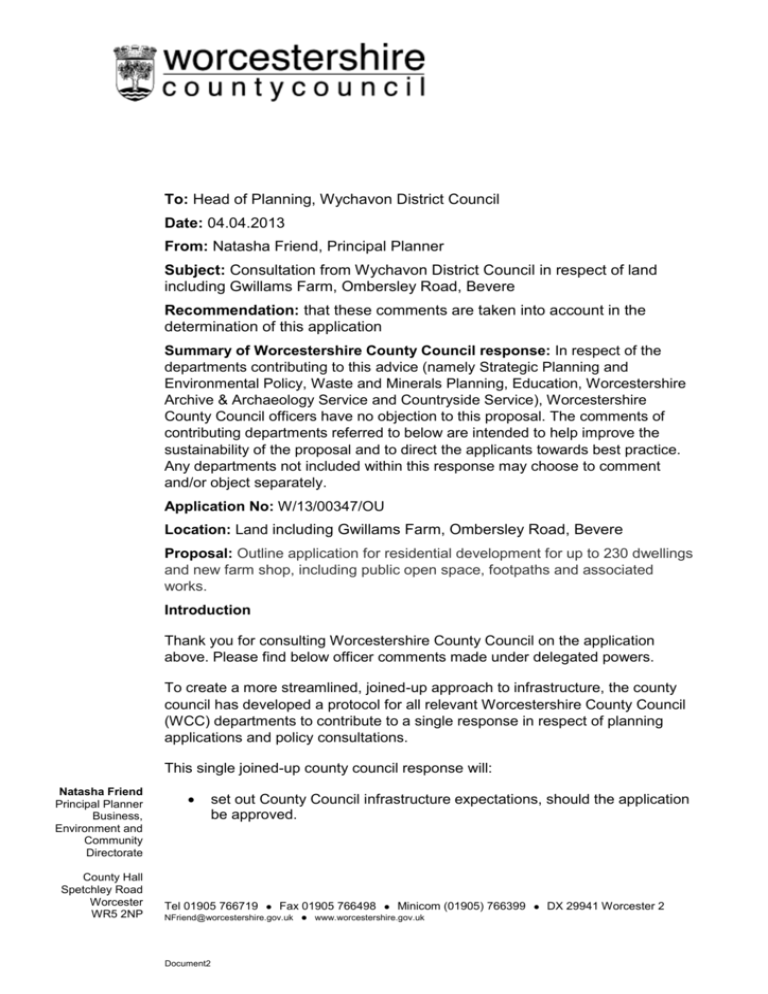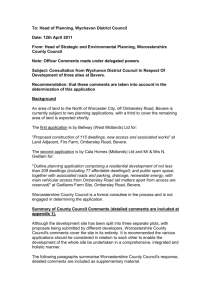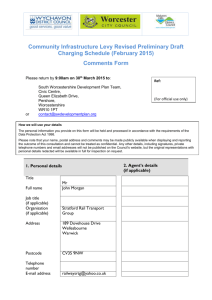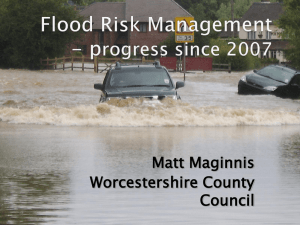IiPLet97 - Wychavon District Council
advertisement

To: Head of Planning, Wychavon District Council Date: 04.04.2013 From: Natasha Friend, Principal Planner Subject: Consultation from Wychavon District Council in respect of land including Gwillams Farm, Ombersley Road, Bevere Recommendation: that these comments are taken into account in the determination of this application Summary of Worcestershire County Council response: In respect of the departments contributing to this advice (namely Strategic Planning and Environmental Policy, Waste and Minerals Planning, Education, Worcestershire Archive & Archaeology Service and Countryside Service), Worcestershire County Council officers have no objection to this proposal. The comments of contributing departments referred to below are intended to help improve the sustainability of the proposal and to direct the applicants towards best practice. Any departments not included within this response may choose to comment and/or object separately. Application No: W/13/00347/OU Location: Land including Gwillams Farm, Ombersley Road, Bevere Proposal: Outline application for residential development for up to 230 dwellings and new farm shop, including public open space, footpaths and associated works. Introduction Thank you for consulting Worcestershire County Council on the application above. Please find below officer comments made under delegated powers. To create a more streamlined, joined-up approach to infrastructure, the county council has developed a protocol for all relevant Worcestershire County Council (WCC) departments to contribute to a single response in respect of planning applications and policy consultations. This single joined-up county council response will: Natasha Friend Principal Planner Business, Environment and Community Directorate County Hall Spetchley Road Worcester WR5 2NP set out County Council infrastructure expectations, should the application be approved. Tel 01905 766719Fax 01905 766498Minicom (01905) 766399DX 29941 Worcester 2 NFriend@worcestershire.gov.ukwww.worcestershire.gov.uk Document2 advise how far the application generally conforms to County Council's priorities as set out in its strategies and plans, including the Corporate Plan; and highlight any specific areas of planning concern/support arising from the application proposal, such as potential conditions and phasing requirements. This response comprises officer only comments from Strategic Planning and Environmental Policy, Waste and Minerals Planning, Education, Countryside Service and Worcestershire Archive & Archaeology Service, however, does not include any comment from WCC's Highways department, who will respond separately. . Infrastructure Expectations Landscape Most of the site is elevated flat agricultural land on the northern border of Worcester. It has been identified as Landscape Type Settled Farmlands on River Terrace by the County Landscape Character Assessment but the landscape of the site is in a degraded condition with few of the characteristic features surviving. The site lies adjacent to the Bevere Conservation Area along its western and northern boundaries. The western part of the site relates visually to the Conservation Area and the assemblage of buildings and trees related to the historic park and gardens of Bevere House and Bevere Manor. This is an important historic designed landscape which also incorporates Bevere Green and is one of the few intact historic designed landscapes in the immediate vicinity of the City. It is closely associated with Dr. Nash who lived at Bevere House and with Anthony Keck who carried out various architectural improvements in the 18th century. The western part of the site is therefore particularly sensitive in historical and visual terms. The northern part, bordering the lane (also Conservation Area) is also sensitive. Although the proposed development does show open green space along the north-western boundary, it is not considered sufficient to provide an adequate buffer and landscape screen to the Bevere Conservation Area. Additionally, the built development is shown as extending through to Northwick Road along the south-western site boundary. Although the land on the other side of this lane is not in the Bevere Conservation Area, it is part of the "bosky" setting that contributes to its character. We consider that development so close to this road will compromise the setting of the eastern part of the Conservation Area. We recommend that the Applicant is requested to increase the open green space along the western boundary, removing the built development shown adjoining Northwick Road. Public Rights of Way The development currently proposed and illustrated on the Indicative Masterplan No.B5165 will affect two Public Rights of Ways (PROW) as recorded on the Definitive Map and Statement for Worcestershire (relevant date 31 March 2005): Footpath NC-511 passing along the north western boundary and Footpath NC-513 following the north eastern boundary of the development site. It is understood that there is no intention to disturb these footpaths but to retain them in their current position and incorporate them within land designated 'green corridors', a network of pedestrian access and Public Open Space provision, as illustrated on the Masterplan. Where existing PROWs are incorporated into a development and also where new ones are proposed, the following principles should be included in the design stage, to reduce the potential for conflict between path users and residents: Ensure routes are direct, well-lit, open and clear of hiding places; Set routes in a landscaped areas to avoid potential nuisance to neighbouring properties and if possible keep routes away from sides and rear of properties; All routes should be surfaced with appropriate materials and constructed to a specification sufficient to cope with anticipated levels of public use. Where a route is designated a shared pedestrian/cycleway, ensure It is of sufficient width to accommodate both cycle and pedestrian use in safety. If it is intended to enclose by fencing, hedging or buildings any part of the proposed network of routes, it is strongly recommended that the Countryside Service Access Team is consulted for advice on the width to be retained for public access. As a general rule, the Countryside Service refers to the Rights of Way Review Committee Practice Guidance Notes No.6 [Planning and Public Rights of Way S.1v. para. 8] and so would require a minimum width 4 metres and with a desired width of 5 metres. Should it subsequently prove necessary to divert PROWs (or parts of them) this should be completed before any development affecting them is started. Application to divert should be made to the planning authority, although advice and guidance concerning public access, including detailed specifications and the legal requirements for diverting public rights of way, is available from the Countryside Service Access Team. New housing development can often lead to significant additional use of PROW in the vicinity of the development area. This additional use can cause problems if PROWs are, for example, unsurfaced and have not historically carried large volumes of users. In these cases the Countryside Service may assess the impact of the development on the wider PROW network and may seek financial contributions from developers to make improvements to accommodate additional public use. Flood Risk and Drainage These comments represent those of Worcestershire County Council as the Lead Local Flood Authority (as determined by the Flood and Water Management Act 2010) and are officer comments only. Full details of Worcestershire County Council role as the LLFA can be found in appendix 1. Summary In general we support the principle of attenuating run-off onsite and utilising SuDS measures. We would however welcome further consideration of the concerns identified below namely the use of surface levels SuDS rather than geo-cellular storage and the design of ponds to include opportunities for biodiversity enhancement such as reed beds. Detailed comments The principle of achieving nil run - off to surroundings via the use of multiple source control measures is welcomed. We also welcome inclusion of the proposed infiltration basin and treatment swale and the opportunities these may present for improvements in water quality. While we note in paragraph 3.2.14 that discussion has taken place with the Highways Authority and the Wychavon District Council Landscape Team. We note the absence of any evidence of correspondence or pre-application with the South Worcestershire Drainage Partnership officers or indeed the LLFA. This omission may be in error however given the roles outlined above we would welcome further clarification of these discussions. As part of a multifunctional approach to green infrastructure and opportunities for biodiversity again and habitat connectivity we would welcome the inclusion of reed beds and other appropriate habitats as part of the infiltration basins. With reference to the proposals to drain the roads shown in red to a cellular storage and infiltration structure located beneath an area of public open space. Given the significant proposals for open space provision in the north of the site and through the central spine, we would question the reason and justification for utilising geo-cellular storage in this location. The provision of SuDS at surface level could help enhance the provision of green infrastructure and landscape connectivity whilst also improving the aesthetic value of the public realm. We would therefore request consideration of introducing a pond or basin feature in this location. Paragraph 3.1.3 - states that "the existing farm shop will be retained in its current position". However, it is our understanding that the existing farm shop is to be replaced as part of the development proposals as indicated in the submitted masterplan proposals. We would welcome further clarification on this matter and any proposals to address drainage and surface water management related to it. The South Worcestershire Water Cycle Study identified that "water resources are scarce within the region. Catchment Abstraction Management Strategies produced by the Environment Agency show that the surface water and groundwater in the study area is either being over-abstracted or there is no water available for further abstractions." And "Severn Trent Water predict a net increase of approximately 31Megalitres/day (Ml/d) in water consumption from 2006 – 2035 in their Severn Water Resource Zone. The supply/demand balance for the zone became negative in 2006/2007. The current projected supply/demand shortfall is around 120Ml/d by 2035, taking into account the effects of climate change. This shortfall will arise if no further investment was made to leakage reduction, demand management and resource development." Whilst we welcome the inclusion of measures to enable infiltration of surface water and the proposals to introduce water butts on properties. Given, the findings of the WCS we are disappointed to note the submitted conclusion that water capture and water recycling are not suitable for the proposed residential dwellings. With regards to water management and addressing issues of water stress we would welcome the identification of opportunities for water capture and recycling associated with the farm shop. Waste and Minerals Minerals The application site is within an identified aggregate deposit. (See County of Hereford and Worcester Minerals Local Plan Proposals Map). Saved Policy M.2 of the Worcestershire Structure Plan is therefore relevant to the consideration of this application. "Safeguarding Deposits Policy M.2 Known mineral deposits will be safeguarded as far as possible. Proposals for development which would sterilise them or prevent them being worked will be resisted unless: (i) it can be demonstrated that no workable deposit exists; or (ii) the mineral is extracted prior to the commencement of the proposed development; or (iii) extraction is not possible without unacceptable effects on the environment." The Council is not aware of any information provided by the applicant that address these points. More information is therefore required to assess whether this application is in accordance with this policy in the development plan. If you wish to discuss this further please contact Nick Dean, Minerals and Waste Policy Manager (01905) 766374. Waste It is noted that Section 5 of the Planning Statement outlines the development plan but makes no reference to the Waste Core Strategy which is part of the adopted development plan in Worcestershire. Policy WCS 17 is relevant to the consideration of this application. "Policy WCS 17: Making provision for waste in all new development Proposals for new development will be permitted where: a) they incorporate facilities into the design that allow occupiers to separate and store waste for recycling and recovery; or b) developer contributions are made, for proposals where this is more appropriate than provision of on-site facilities; or c) the existing provision is adequate." The reference to "Provide facilities to recycle and compost household waste, reducing the amount of household waste sent to landfill" and to "Implement an element of construction waste reduction or recycling" in the Sustainability section of the Design and Access Statement is welcomed. The Design and Access Statement states that "Each dwelling will have access for wheelie bins to be collected from driveways via the adopted road. In courtyards, shared surfaces and some private drives or lanes, wheelie bin collection points are built into the streetscape within 30m of dwellings. Collection points will be located so that they are within 25m of the waste collection vehicle". If this includes facilities for the separate storage of waste for recycling this would be considered to be accordance with policy WCS17, however further information should be sought to clarify if this provision will be made. Archives and Archaeology The County Historic Environment Record shows that this application affects or may effect a heritage asset or area of archaeological potential (WSM11379). The 'historic environment' encompasses all those material remains that our ancestors have created in the landscapes of town and countryside. It includes all below and aboveground evidence including buildings of historic and architectural interest. In line with comments made for the previous (withdrawn) application, we advise that further information in the form of an archaeological field evaluation is required. The site contains known buried archaeological remains, the significance of which have yet to be established. We advise that either a total area geophysical survey augmented with targeted evaluation trenching, or a 4% grid array of evaluation trenching be undertaken in order to provide sufficient information to be able to determine the outline application. In line with government policy given in the National Planning Policy Framework, (paragraph 128), it has been demonstrated that the proposed development area will affect a known heritage asset and that further information on the nature, extent and significance of any of that asset, and the potential impact of the proposed development on said asset is required before this application can be determined. "Where a site on which development is proposed includes or has the potential to include heritage assets with archaeological interest, local planning authorities should require developers to submit an appropriate desk-based assessment and, where necessary, a field evaluation." In this instance it is advised that a field evaluation, as required under paragraph 128 of the NPPF, should be provided before this application can be determined. Please Note: A fee will be charged to the applicant for the formal provision of archaeological briefs, and for the checking and acceptance of Written Schemes of Investigation and Archaeological reports required by the local planning authority. The applicant or their successor in title must contact Worcestershire Archive & Archaeology Service to arrange provision of the brief as soon as possible. Worcestershire Archive & Archaeology Service will be able to provide details of the fees payable. It will be the applicant’s (or their successor in title) responsibility to contract an appropriate archaeological organisation to undertake the programme of works as detailed in the brief. Education Children's Services will be seeking an education contribution in line with our current policy. The contribution will be calculated on the basis of the following cost per dwelling from the 2012/13 table of charges: Primary School Claines CE Primary Middle School High School Tudor Grange Academy 1-bed contribution £0 2-bed contribution 3-bed contribution 4+-bed contribution Flats Social Housing £2,119 £2,119 £3,179 £848 £0 The contribution will be used to fund capital projects in schools local to the development. Concluding Remarks WCC does not object to the principle of development in this location, subject to acceptable resolution of the issues identified above, namely that more information is required. It is worth noting, once again, this response is officer only comments and does not include any comment from WCC's Highways department, who will respond separately. Yours sincerely Natasha Friend Principal Planner Appendix 1 The Flood and Water Management Act (FWMA) delegated upper-tier and unitary authorities as Lead Local Flood Authorities (LLFA) with responsibility for their respective area's Local Flood Risk Management. Worcestershire County Council is therefore the LLFA for Worcestershire. This role currently relates to ordinary watercourses, surface water and groundwater flooding (fluvial flooding from main tributaries is still currently the responsibility of the Environment Agency). As LLFA for Worcestershire, the County Council needs to ‘develop, maintain, apply and monitor’ a Local Flood Risk Management Strategy (LFRMS). The Strategy will focus on local flood risk due to flooding from surface water, groundwater and ordinary watercourses and must be consistent with the Environment Agency’s National Flood Risk Management Strategy for England. Work is currently ongoing by the County Council and partners in developing the Worcestershire Local Flood Risk Management Strategy. There are a number of organisations with statutory roles and others with an interest in local flood risk management. Relevant organisations are required "to act consistently with and/or have due regard for the strategy" and have "a duty to exercise their flood risk management functions in a manner consistent with local and national strategies, and to have regard to those strategies in their other functions". The Act defines various bodies as Risk Management Authorities (RMAs): The Lead Local Flood Authority; The Environment Agency; District or Borough councils; Internal drainage board; Water companies; The Highway Authority. The FWMA has also delegated a number of other statutory powers and duties extending their previous responsibilities for flood risk management, including: Powers to request information from any person in connection with the authority's flood and coastal erosion risk management functions; A duty to investigate and publish reports on flooding incidents in its area (where appropriate or necessary) to identify which authorities have relevant flood risk management functions and what they have done or intend to do; A duty to maintain a register of structures or features which have a significant effect on flood risk in their area, in the view of the lead local flood authority; Power to do works to manage flood risk from surface runoff or groundwater; Power to designate structures and features that could affect flooding and are considered to be significant when assessing local flood risk; A duty to establish a Sustainable Drainage Systems (SuDS) Approving Body (SAB) with responsibility for approval of all drainage plans and the adoption and maintenance of SuDS that serve more than one property in new developments (implementation expected by October 2013); Following commencement of paragraphs 32-34 of Schedule 2 of the FWMA on 6th April 2012 transfer has been made of the regulatory powers (consenting and enforcement) on Ordinary Watercourses from the Environment Agency to LLFAs (internal drainage boards will still have this role on ordinary watercourses in their system). As permitted by the FWMA, a number of statutory functions of the LLFA have been delegated to the District Drainage authorities. For South Worcestershire this is the South Worcestershire Drainage Partnership. This currently includes the ordinary watercourse consenting function. Applicants are advised to enter into pre-application discussions with the LLFA and (in this instance) the South Worcestershire Water Drainage Partnership to discuss any localised flooding issues.








